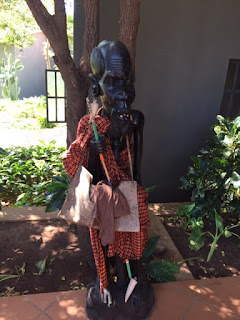Zanzibar was an independent nation in the early 1960s when most of the African colonies gained their independence. However, its small size and concern over the interest Arab nations had, Zanzibar decided to unite with Tanganyika to form the nation of Tanzania. Originally settled by Arab traders, it became a slave bazaar and spice island. Stone Town is the original city. The central city still has the narrow winding streets one expects in old cities and towns built before the age of cars and their wider street requirements. Since our hotel was in the middle of Stone Town, we had to walk about ten minutes from the car park. Given the heat and humidity, we were thankful that the porters took care of our luggage.
 |
| Our Hotel |
Emerson Spice Hotel is a great old building with two or three large rooms on each of the first five floors. On the sixth is a rooftop restaurant. Each room has a theme based on an opera or one of the owners favorite actresses including Katherine Hepburn and Dorothy Lamour. Our room, Violetta, is dedicated to the lead character in Verdi’s “La Traviata” based on Alexander Dumas’s “La Dame aus Carmelias.” Decorated in shades of violet and blue it looks like a courtesan’s boudoir. Fortunately, it also has air conditioning and a nice balcony in the shade where I sat to watch the city activity. A couple of street vendors compete with the shops. Carts, motorcycles, and pedestrians keep up a constant motion so there is always something to look at.
 |
| Street Scenes |
We had not arrived until 3:00 so we showered and rested until time for a G&T at the rooftop bar. Mango Travel already made a reservation for our dinner so we did not have to think about what to do. The five course meal was headlined by Kingfish in coconut sauce and accompanied by a fine South African wine. Everything was perfectly cooked and described in detail by our waiter. The cool breeze as the sun disappeared over the horizon made for a perfect ending to the day
The next morning began with breakfast atop the hotel. A breeze and canopies kept the temperature down so we could enjoy the breakfast of fruit and eggs cooked to our specifications. Following the meal we made our way to the lobby where we meet Joseph, our guide for the tour of the city. We began with a walk through the market, similar to other markets we have seen although it did have a much stronger emphasis on spices.



From the market it is just a short walk to the slave market and museum. Like other places where slavery was a major part of the past, Zanzibar has taken several steps to make sure that this dark blot on its past is not forgotten. The museum is filled with panels of text and pictures that bring the issue of slavery up to the present. Today, Zanzibar is looking at the idea the marriage sometimes can be a form of slavery when a man divorces one wife so he may marry another. The ugliest part of the museum is the downstairs pair of rooms where slaves awaited shipment. The rooms were too low for standing tall and too small for the numbers that were kept there.




Upon leaving the museum we crossed the plaza to see the sculpture of chained slaves awaiting shipment. Then we entered the Anglican cathedral where we enjoyed a short rest as we admired the furnishings including a cross made from the tree in Zambia under which David Livingston’s heart is buried. The rest of his body is in England. Livingston is much admired in Africa for his anti-slavery work.




Our next stop across town was the Africa House built by the British as a place where they could enjoy a drink and fine food overlooking the water. We took the elevator to enjoy the view. In retrospect we should have stopped for a drink and a real rest as the day was getting hotter and we were getting more tired. At least we made a stop to get some cold water and then a stop in Memories, a souvenir store where we did buy a couple of souvenirs before heading out again.
Joseph then led us past the Old Fort, the Palace Museum, and the House of Wonders. The House of Wonders was closed for repairs. The House of Wonders is so-called because it was the first in East Africa to have electricity and an elevator. We chose to merely look at the others from the outside as it was now near 1:00 and we were totally sapped by the heat and humidity.
 |
| Sea shells and coral are used in the mortar |
 |
| The British Club |
Upon returning to the hotel, we learned that Mango Safaris (our marvelous travel agent) was providing us with dinner at Hurumzi, sister hotel to Emerson Spice. We needed a guide to lead us there that evening. While only a couple of blocks away, it required six turns as we walked through the narrow streets. Four flights of stairs took us to their rooftop restaurant where we were treated to another fun dinner in the style of a typical Zanzibarian wedding. Each course we served family style accompanied by music and dancing. As the previous evening, we thoroughly enjoyed eating in the cool of the rooftop as we enjoyed the setting sun and accompanying entertainment.
 |
| Being greeted for dinner |
 |
| Stairway to the rooftop |




















































